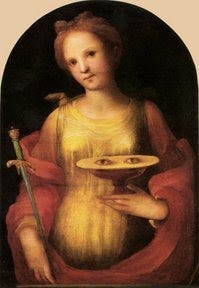
In Sweden, December 13 is “Luciadagen,” Santa Lucia’s Day, or St. Lucy’s Day in English. It is the beginning of their holiday season. The Lutheran Danes and Norwegians also celebrate this day.
How did St. Lucy’s Day become popular throughout European countries, especially in Scandinavian countries, Sicily, and the Caribbean?
History
St. Lucia was a young woman who lived in first-century Rome. She was a Christian who would not give up her faith to marry an unbeliever. She was tortured and killed by order of the Roman magistrate Paschasius, who ordered her to burn a sacrifice to Emperor Diocletian‘s image. As the ultimate torture, her eyes were gouged out, but she was miraculously still able to see. Pictures depict her holding her eyes on a golden plate, as she remains the patron saint for the blind. Dante subsequently mentions Lucia in the Second Canto of his Divine Comedy.
Missionaries brought stories of her courage to Sweden, where she became known as the Lucia Bride. Older people said the Lucia Bride would go out early in the morning to bring food and drink to the poor. She wore white robes and a crown of light. Lucy, like the Latin lux, means light. Under the old calendar before calendar reforms, her day was the shortest of the year.
St. Lucia in Swedish Tradition

The story of Luciadagen is acted out in Swedish homes, with the oldest daughter playing the Lucia Bride. Early in the morning on December 13, she brings her parents a tray of sweet saffron buns and some coffee. She wears a white gown and a crown of greens, often made of holly. Her sisters and brothers dress in white and follow her. The girls carry lit candles, and the boys wear tall, pointed caps and are called “star boys.”
Santa Lucia in Sicily
St. Lucia is also honored in Sicily, where she was born, and is the patron saint of Syracuse and known as Santa Lucia. Christians there gather to celebrate her day with bonfires and torchlight parades.
St. Lucia in the Caribbean
There is an island in the Caribbean named St. Lucia, after the Sicilian saint. It is one of two sovereign states in the world named after a woman. The other country is Ireland, named after the local goddess, Ériu. I visited St. Lucia last year.
Bill Petro, your friendly neighborhood historian
billpetro.com
Podcast:
Subscribe to have future articles delivered to your email. If you enjoyed this article, please consider leaving a comment.



